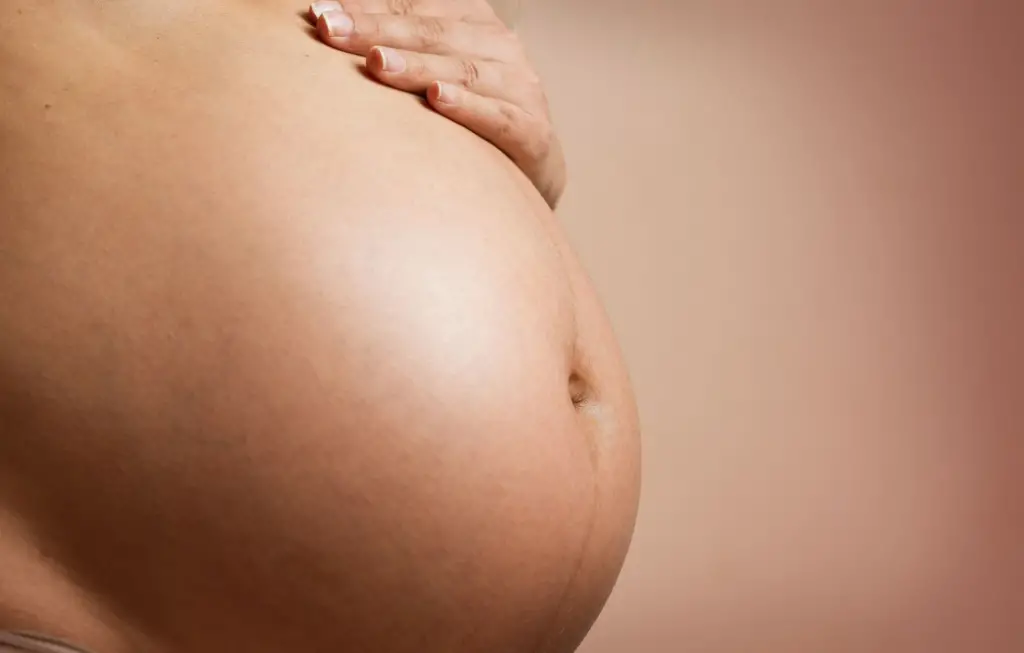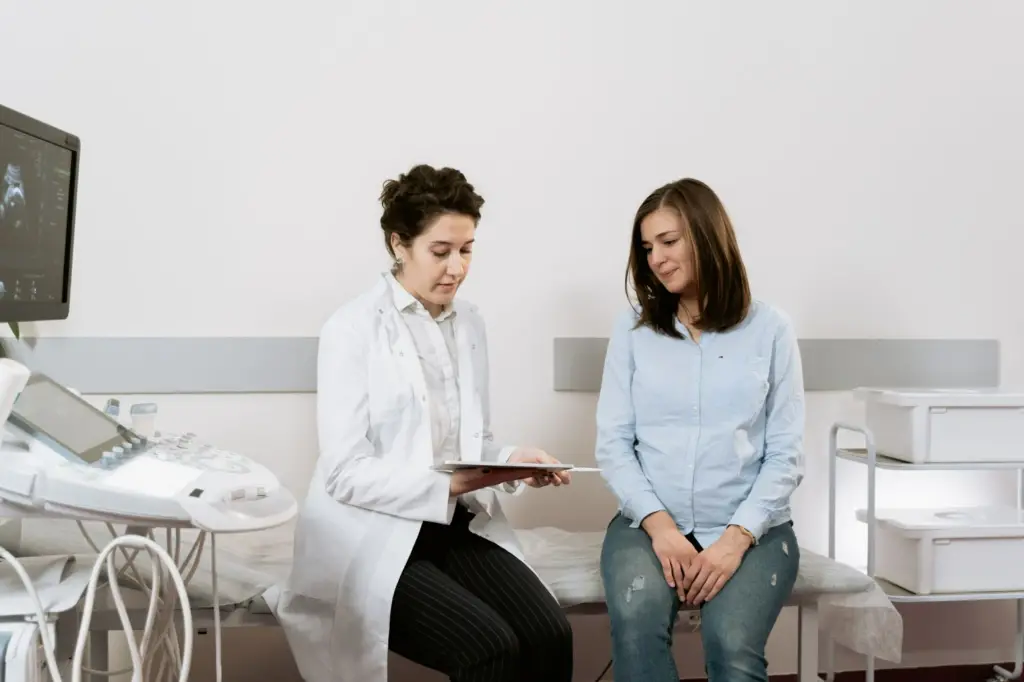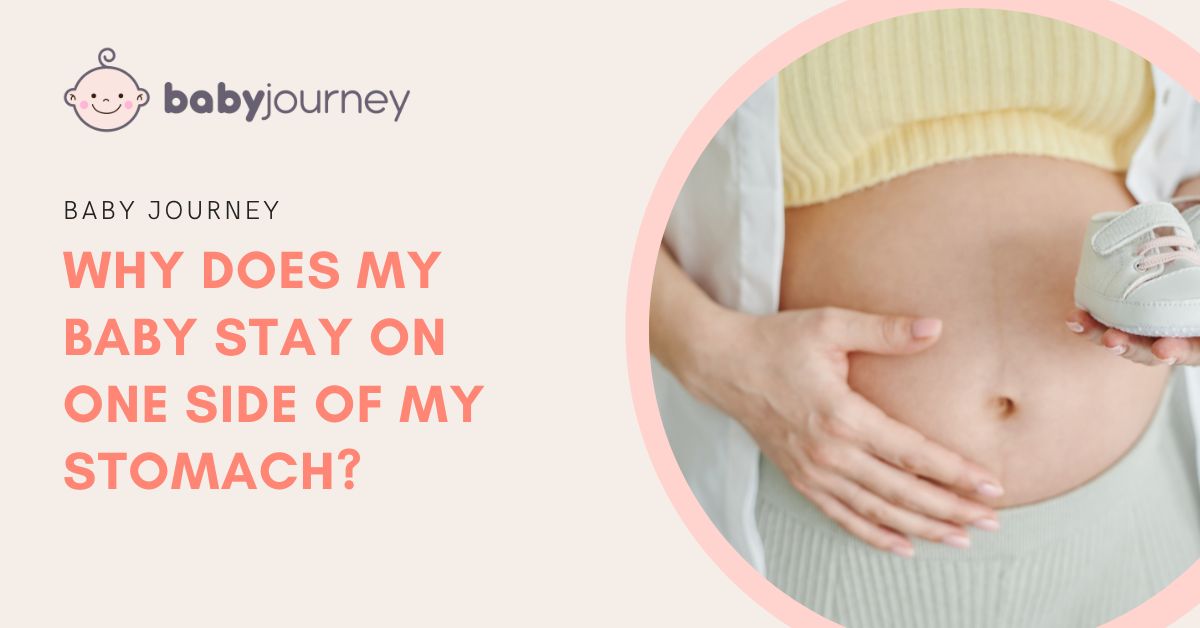It is common for expectant mothers to notice their baby staying on one side of their stomach. This can be a cause for concern and leave mothers wondering why their baby is favoring one side. While there can be a variety of reasons for this, there are a few common explanations.
Why does my baby stay on one side of my stomach? One reason for a baby staying on one side of the stomach could be due to the position of the uterus. If the uterus is tilted or has an anomaly such as a bicornuate uterus, the baby may stay in one position within the uterus. Another explanation could simply be that the baby prefers that side of the uterus. It is important to note that a baby’s position in the uterus can change frequently throughout pregnancy, so there is no need to panic if they seem to favor one side at first.
It is also worth noting that the baby’s position in the uterus can have an impact on the mother’s comfort level during pregnancy. If the baby is consistently on one side, it can cause discomfort or pain for the mother. It is important to speak with a healthcare provider if there are concerns about the baby’s position or if the mother is experiencing discomfort.
Causes of One-Sided Baby Positioning

As a baby grows in the womb, they may take on different positions that can affect their placement in the birth canal. One of the common baby positions is when their head is tilted to one side, which means that their head isn’t in line with the birth canal. This can cause the baby to stay on one side of the mother’s stomach.
There are several factors that can contribute to a one-sided baby positioning. These include:
1. Uterine Anomalies
A baby may stay in one position within the uterus due to a uterine anomaly such as a bicornuate uterus. This condition can cause the uterus to have an unusual shape that can affect the baby’s position.
2. Limited Space in the Womb
As the baby grows, they may have limited space in the womb, which can cause them to stay in one position. This can happen if the mother has a small pelvis or if the baby is larger than average.
3. Baby’s Preference
Sometimes, a baby may simply prefer to stay on one side of the mother’s belly. This can be due to factors such as the baby’s comfort or the position of the placenta.
4. Baby’s Movement
In some cases, the baby’s movement may be dominant on one side of the mother’s belly. This can be due to the baby’s gross motor development on one side of their body.
It’s important to note that a one-sided baby positioning is not necessarily a cause for concern. However, if the baby’s position is causing discomfort or if it’s affecting the delivery, the doctor may recommend certain measures to help turn the baby into a more favorable position.
Effects of One-Sided Baby Positioning

When a baby stays on one side of the stomach, it can have several effects on both the mother and the baby. Here are some of the potential effects:
Pressure on One Side
When the baby stays on one side of the stomach, it can create pressure on that side, which can cause discomfort for the mother. This pressure can also lead to back pain, hip pain, and other discomforts.
Head Position
The position of the baby’s head can also be affected by one-sided positioning. If the baby is facing down, with their head on one side of the stomach, it can cause the baby’s head to be misshapen or flattened on that side. This can be temporary or permanent, depending on the severity of the condition.
Oxygen Flow
One-sided positioning can also affect the flow of oxygen to the baby. If the baby is positioned in a way that restricts the flow of oxygen, it can lead to complications and health issues for the baby.
Arm Position
The position of the baby’s arms can also be affected by one-sided positioning. If the baby is lying with their arms on one side of the stomach, it can cause the arms to be in an uncomfortable position. This can lead to discomfort for the baby and can affect their development.
Kicks and Movement
When the baby stays on one side of the stomach, it can affect the mother’s ability to feel the baby’s kicks and movements. This can be concerning for some mothers, as it can make them worry about the baby’s health and well-being.
Overall, one-sided baby positioning can have several effects on both the mother and the baby. It is important for mothers to talk to their healthcare provider if they have concerns about their baby’s positioning or any discomfort they are experiencing.
Safety Concerns with One-Sided Baby Positioning

Many pregnant women notice that their baby tends to stay on one side of their stomach. While this is usually not a cause for concern, parents should be aware of the potential safety risks associated with one-sided baby positioning.
Understanding fetal positioning is important for pregnant women. Fetal positioning can vary throughout pregnancy, and it’s not uncommon for babies to favor one side of the uterus over the other, but it’s important to note that certain positions, such as the transverse lie position, can pose risks during delivery. If the baby is in an anterior position , which means that the baby is head down with their face facing the mother’s back, this can cause the baby to lean more towards one side of the stomach. However, as the baby grows and approaches delivery, they will usually settle into a head-down position, also known as cephalic presentation.
On the other hand, if a baby in a posterior position, which is head-down but facing the mother’s abdomen, may cause discomfort and back labor during delivery, and may also explain why the baby stays on one side of the mother’s stomach
One of the biggest concerns with one-sided baby positioning is the risk of Sudden Infant Death Syndrome (SIDS). The American Academy of Pediatrics (AAP) recommends that babies be placed on their backs to sleep, as this is the safest sleep position and reduces the risk of SIDS. However, if a baby is consistently positioned on one side in the womb, they may have a preference for that position after birth, which could increase the risk of SIDS if they are placed on their stomach to sleep.
Another concern with one-sided baby positioning is the risk of suffocation. If a baby is positioned with their face against the mattress or other soft surfaces such as pillows or blankets, they may not be able to breathe properly. It is important to ensure that the baby’s sleeping area is free of any soft objects that could obstruct their airway.
Parents should also be aware of the risks associated with baby swaddling. While swaddling can help soothe a fussy baby and promote sleep, it can also increase the risk of suffocation or overheating if not done properly. The AAP recommends that parents stop swaddling their baby once they begin to roll over, which typically occurs around 4-6 months of age.
It is important for parents to discuss any concerns about one-sided baby positioning with their pediatrician. In some cases, one-sided baby positioning may be due to a medical condition such as torticollis, which can be treated with physical therapy. Additionally, if a baby is consistently positioned on one side in the womb, it may be a sign of a uterine anomaly such as a bicornuate uterus, which can increase the risk of complications during pregnancy and delivery.
Overall, while one-sided baby positioning is usually not a cause for concern, parents should be aware of the potential safety risks and take steps to ensure their baby sleeps safely.
How to Encourage Balanced Baby Positioning
During pregnancy, it’s common for a baby to stay on one side of the stomach. However, it’s important to encourage balanced baby positioning to ensure a smooth delivery. Here are some tips to help encourage your baby to move into a balanced position:
1. Practice Good Posture
Poor posture can contribute to a baby staying on one side of the stomach. Encourage good posture by sitting up straight and avoiding slouching. You can also try sitting on an exercise ball or using a pregnancy pillow to help support your back.
2. Stay Active
Staying active during pregnancy can help encourage your baby to move into a balanced position. Walking, swimming, and prenatal yoga are all great ways to stay active. However, it’s important to avoid high-impact exercises or activities that could put you at risk for injury.
3. Take Breaks
If you have a job that requires you to sit for long periods, it’s important to take breaks and move around. This can help encourage your baby to move into a balanced position. You can also try lying on your side for short periods throughout the day.
4. Sleep on Your Side
Sleeping on your side can help encourage your baby to move into a balanced position. It’s recommended that pregnant women sleep on their left side to improve blood flow to the placenta. You can also try using a pregnancy pillow to help support your back and stomach while you sleep.
5. Consider Chiropractic Care
Chiropractic care can help encourage balanced baby positioning by ensuring that the pelvis is properly aligned. However, it’s important to only see a chiropractor who is trained in prenatal care.
By following these tips, you can help encourage your baby to move into a balanced position. However, it’s important to remember that every pregnancy is different, and some babies may still stay on one side of the stomach despite your best efforts. If you have concerns about your baby’s positioning, talk to your healthcare provider.
When to See a Doctor

If a baby consistently stays on one side of the belly, it is important to consult with a doctor. While it is common for babies to move around and change positions in the womb, consistently staying on one side may indicate a problem.
If a pregnant woman notices that her baby is always on the left side, it could be a sign of a problem with the uterus or placenta. A doctor should be consulted immediately to ensure that the baby is healthy and growing properly.
If a woman is in labor and the baby is not moving from one side of the belly, it could be a sign of a problem with the baby’s position. In some cases, a baby may be in a breech position, which can be dangerous during delivery. If a woman is in labor and the baby is not moving, it is important to seek medical attention immediately.
Rolling over onto the left side during pregnancy can be beneficial for both the mother and the baby. It can improve blood flow to the placenta and reduce the risk of stillbirth. If a woman is having trouble sleeping on her left side, she should talk to her doctor about solutions.
If a woman is experiencing pain or discomfort on one side of her belly, it could be a sign of a problem with the baby or the uterus. A doctor should be consulted immediately to determine the cause of the pain and ensure that the baby is healthy.
In summary, if a baby consistently stays on one side of the belly, or if a woman is experiencing pain or discomfort on one side of her belly, it is important to consult with a doctor. A doctor can determine the cause of the problem and ensure that the baby is healthy and growing properly.
Frequently Asked Questions
Why does my baby stay on one side of my stomach?
There are several reasons why a baby may stay on one side of the stomach. It could be due to the shape of the uterus or the baby’s position. Some babies may prefer a certain position and stay there for longer periods.
Is it normal for a baby to stay on one side of the stomach?
Yes, it is normal for a baby to stay on one side of the stomach. As long as the baby is healthy and growing, there is no need to be concerned.
My baby kicks more on the right side, why?
My baby kicks more on the right side why? Babies can move and kick more on one side due to their position in the uterus. It could also be due to the shape of the uterus or the baby’s preference for a certain position.
My baby kicks more on the left side, why?
My baby kicks more on the left side why? Similar to kicking more on the right side, babies can kick more on the left side due to their position in the uterus or their preference for a certain position.
What does it mean if my baby stays on one side of my belly?
If your baby stays on one side of your belly, it could be due to the shape of the uterus or the baby’s position. It is a normal part of fetal movement.
Does the side of the belly where the baby stays indicate the gender?
No, the side of the belly where the baby stays does not indicate the gender. The position of the baby in the uterus is not related to their gender.
Why do I only feel my baby move on one side of my belly?
Feeling the baby move on one side of the belly could be due to the position of the baby in the uterus or the shape of the uterus. It is also possible that the baby’s movements are easier to feel on one side.
Conclusion
In conclusion, there are a variety of reasons why a baby may stay on one side of the stomach. It is important to note that this is a common occurrence and is not necessarily a cause for concern. If a mother notices that her baby is consistently on one side of the stomach, it is recommended that she speak with her healthcare provider to ensure that everything is progressing normally.
Some potential reasons why a baby may stay on one side of the stomach include the position of the uterus, the amount of amniotic fluid, and the baby’s preference. It is also possible that a baby may be positioned in a way that makes it more comfortable for them to stay on one side of the stomach.
While it is important to be aware of potential issues, it is equally important not to panic or jump to conclusions. As always, it is recommended that mothers speak with their healthcare provider if they have any concerns or questions about their pregnancy. By working closely with their healthcare provider, mothers can ensure that they have a healthy and successful pregnancy.


 PARENTING TIPS
PARENTING TIPS







 PREGNANCY
PREGNANCY








 BABY CARE
BABY CARE








 TODDLERS
TODDLERS








 TEENS
TEENS








 HEALTH CARE
HEALTH CARE






 ACTIVITIES & CRAFTS
ACTIVITIES & CRAFTS








 CONTACT
CONTACT ABOUT
ABOUT















